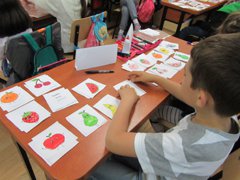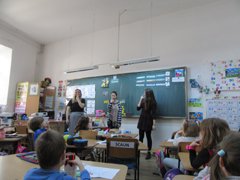Japan, as Taught to Children
University of Bucharest
KURIHARA Sachiko
At the end of last year’s report, I wrote that we are seeing interest in Japan spreading among young people in Romania. In this report, I want to write about examples of Japanese-language and cultural education for young people in Romania in which Japanese-Language Specialists (hereinafter “Specialists”) and Japanese-Language Assistants (hereinafter “Assistants”) are involved.
Japan, as Taught by Students
The Department of Japanese Language and Literature in the Faculty of Foreign Languages and Literatures in the University of Bucharest, which is where Specialists and Assistants are dispatched, has held classes on Japanese-language teaching methods; the Specialists and Assistants have taken responsibility for classes relevant to the CEFR (Common European Framework of Reference for Languages) and the JF Standard for Japanese-Language Education.
In this context, we opened a “Japanese school” at an elementary school in Bucharest for three days in May 2017 as part of a special program called Şcoala Altfel. First- and second-year students from the Japanese Section of the University of Bucharest taught the elementary school students about Japanese language and culture. With the students who attend lessons on Japanese-language education at the center of the planning, the Japanese Studies students thought about lesson content, activities, and ways of teaching that would match the ages of the elementary school students, and created teaching materials. The motivation for holding the “Japanese school” was the fact that a graduate from the Japanese Section of the University of Bucharest is teaching at this elementary school, and their class is learning Japanese songs and Japanese greetings.
We welcomed Japanese Ambassador to Romania Ishii; Director Tada of the Japan Foundation, Budapest; and a representative of the Board of Education to the opening ceremony of the “Japanese school,” and the elementary school students sang a Japanese song.
Around 300 children and students participated in the three-day program from over 10 classes, ranging from children in year 0 (a preparatory class before the first year, age five) to fourth years (age 10), and the Japanese Studies students engaged in different activities depending on the age of the children. They held classes on greetings, self-introductions, hiragana, katakana, and the names of animals, colors, vegetables, and fruit, and when it came to Japanese culture, they covered origami (paper craft), Japanese fairytales, how to use chopsticks, songs, and dances. Of the various clubs connected to Japanese culture in the Japanese Section, the sushi, taiko drumming, dance, indigo dyeing, calligraphy, and origami clubs ran workshops on Japanese culture as part of this program.

Memorizing color and fruit names by coloring pictures
When we first entered the school, the children gave us wondering looks, but by the second half of that first day they strove to be the first to greet us with “Konnichiwa” (Hello) when they saw us. The program was incredibly well received, and we were ranked first within the city of Bucharest in the Şcoala Altfel contest held by the Ministry of Education, and even reached the top ranks on a national level. Şcoala Altfel in other schools had focused on European culture, and it seems that our program themed around Japan was fresh and offered a partial understanding of a different culture. The school itself provided a Japanese language and culture class in its July summer school, and the students of the University of Bucharest once again taught the elementary school students.
At Other Elementary Schools
In addition to this, we held a special Japanese language and culture class in another elementary school in Bucharest over two days in March 2018, in which volunteers from among the second-year students in the Japanese Section taught the children some Japanese and Japanese culture. As year 0 elementary school students were the attendees of this class, our students thought up lessons that would get young children interested, and explained Japan through activities such as picture-story shows and coloring pictures while showing the children dance, origami, furoshiki (wrapping cloth), drawing pictures on uchiwa fans, and Japanese gestures and slides.

Japanese gestures: A nose? No, that means “me!”
Learning through Teaching
The Japanese Section students are learning about Japanese language and culture daily at the University, but that doesn't necessarily mean that they can teach the children in the same way that they learn at the University. Their ages and interests are different, and some of the children have only just started reading and writing in Romanian, their native language. The students have to consider what they will teach and any activities according to the age of the children, as well as class management, the length of the activities, the order, and how to speak.
People learn a lot by teaching (we—the teachers—have also experienced this), and this program is an opportunity for the students of the Japanese Section to look back at the Japanese language and culture that they have learned; many of them have found it fun to teach the children. In addition, we watched the content and activities that the students chose to teach the children as we supported them—we gained various insights by looking at the students’ behavior, and how they differed from regular classes in the University.
These exchange activities will continue in the future. To ensure they are carried out on an ongoing basis, we need to make proposals for activities that will match the ages and interests of the children, and support for the creation of teaching materials. I hope to continue supporting even richer bidirectional exchanges between the students who are doing the teaching and the children.
- What We Do Top
- Arts and Cultural Exchange [Culture]
- Japanese-Language Education Overseas [Language]
- Japanese-Language Education Overseas [Language] Top
- Learn Japanese-language
- Teach Japanese-language
- Take Japanese-Language Test
- Know about Japanese-language education abroad
- The Japanese-Language Institute, Urawa
- The Japanese-Language Institute, Kansai
- Japanese-Language Programs for Foreign Specified Skilled Worker Candidates
- Japanese Language Education for Japanese Children Resident Overseas and for the Descendants of Migrants
- Archives
- Japanese Studies and Global Partnerships [Dialogue]
- JF digital collection
- Other Programs / Programs to Commemorate Exchange Year
- Awards and Prizes
- Publications
